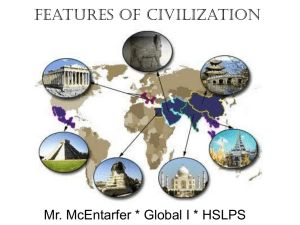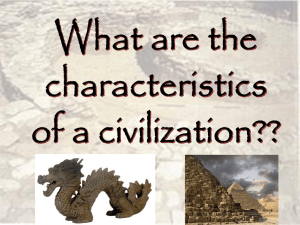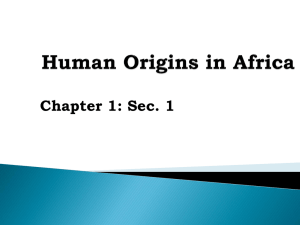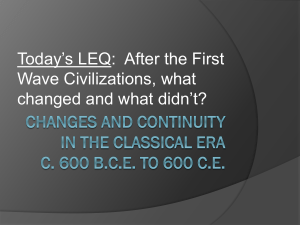Books: - The Political Economy of the World
advertisement
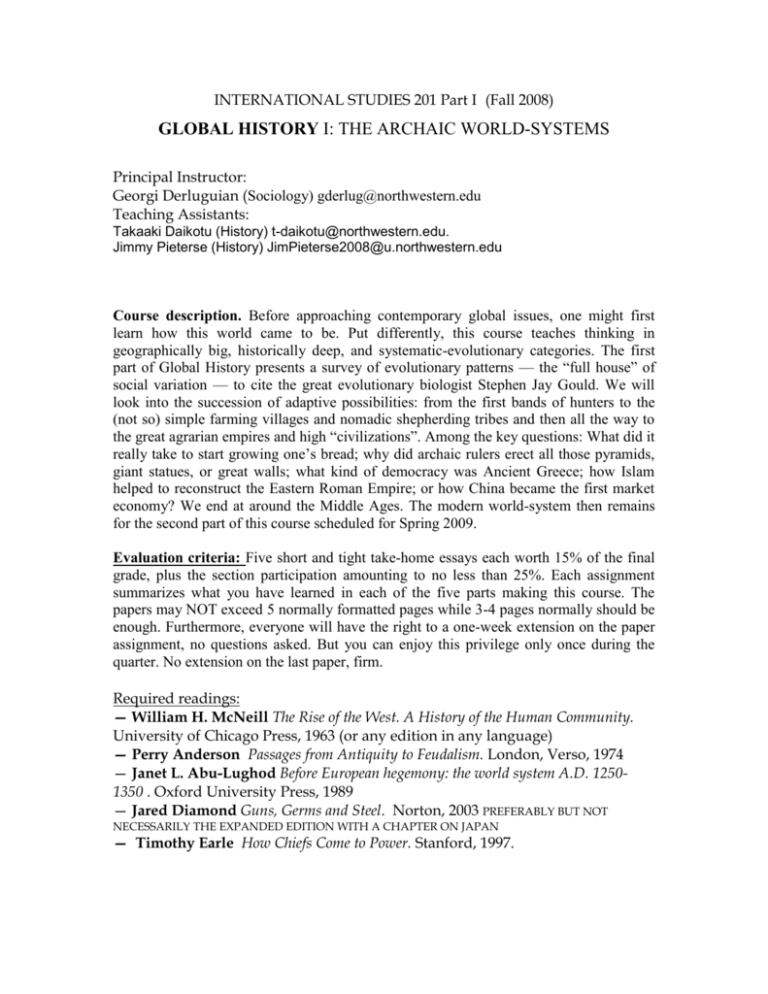
INTERNATIONAL STUDIES 201 Part I (Fall 2008) GLOBAL HISTORY I: THE ARCHAIC WORLD-SYSTEMS Principal Instructor: Georgi Derluguian (Sociology) gderlug@northwestern.edu Teaching Assistants: Takaaki Daikotu (History) t-daikotu@northwestern.edu. Jimmy Pieterse (History) JimPieterse2008@u.northwestern.edu Course description. Before approaching contemporary global issues, one might first learn how this world came to be. Put differently, this course teaches thinking in geographically big, historically deep, and systematic-evolutionary categories. The first part of Global History presents a survey of evolutionary patterns — the “full house” of social variation — to cite the great evolutionary biologist Stephen Jay Gould. We will look into the succession of adaptive possibilities: from the first bands of hunters to the (not so) simple farming villages and nomadic shepherding tribes and then all the way to the great agrarian empires and high “civilizations”. Among the key questions: What did it really take to start growing one’s bread; why did archaic rulers erect all those pyramids, giant statues, or great walls; what kind of democracy was Ancient Greece; how Islam helped to reconstruct the Eastern Roman Empire; or how China became the first market economy? We end at around the Middle Ages. The modern world-system then remains for the second part of this course scheduled for Spring 2009. Evaluation criteria: Five short and tight take-home essays each worth 15% of the final grade, plus the section participation amounting to no less than 25%. Each assignment summarizes what you have learned in each of the five parts making this course. The papers may NOT exceed 5 normally formatted pages while 3-4 pages normally should be enough. Furthermore, everyone will have the right to a one-week extension on the paper assignment, no questions asked. But you can enjoy this privilege only once during the quarter. No extension on the last paper, firm. Required readings: — William H. McNeill The Rise of the West. A History of the Human Community. University of Chicago Press, 1963 (or any edition in any language) — Perry Anderson Passages from Antiquity to Feudalism. London, Verso, 1974 — Janet L. Abu-Lughod Before European hegemony: the world system A.D. 12501350 . Oxford University Press, 1989 — Jared Diamond Guns, Germs and Steel. Norton, 2003 PREFERABLY BUT NOT NECESSARILY THE EXPANDED EDITION WITH A CHAPTER ON JAPAN — Timothy Earle How Chiefs Come to Power. Stanford, 1997. — You need TWO historical atlases by the famous map-maker Colin McEvedy The New Penguin Atlas of Ancient History and The New Penguin Atlas of Medieval History . (London, naturally, the Penguin Press). — Rapa-Nui, the feature film produced by Kevin Costner and directed by Kevin Reynolds, to be shown in class, but you can also buy or rent it. All readings can be purchased from the Norris bookshop. They are also freely available for the 2-hour periods at the Library’s Reserve Reading Room (2nd floor North Tower). Schedule of Fall 2008 classes and readings KWANZA (the FIRST part, let’s count in Swahili for fun). THE INVENTION OF SOCIETY 23/IX Chemsha bongo (in Swahili ‘Scratch the brain’, or simply a puzzle). We talk of cabbages (=staples) and kings (=social complexity), and the politics of spelling daughter. Start reading Jared Diamond’s Guns, Germs, and Steel (GGS, for short) with the Prologue (The regionally differing courses of history, pp. 13-32) and Ch. 2: A Natural Experiment of History (pp. 53-66) Highly recommended for further reading the quintessence of the great American naturalist Stephen Jay Gould Full House: The Spread of Excellence from Plato to Darwin. NY, Random House, 1996. Nota Bene: Discussion sections begin on the first Friday, September 26. 25 /IX “May you toil in sweat!” The difficult road to agriculture. Read from two books simultaneously. From Jared Diamond’s GGS take the mercifully short and very elegantly written Chapter 4 (really a brief synopsis of his whole argument) then chapters 5, 6 and 7 (for brevity, I omit Diamond’s inventive titles and go by the substantive sub-titles: Geographic differences in the onset of food production; Causes of the spread of food production; The unconscious development of ancient crops, i.e. pp. 85 through 130). In lecture I will explain how to read faster and still productively. Now, from the great old McNeill’s Rise of the West you read Ch. 1 In the Beginning (pp. 3-27) If this weren’t enough, for a better grasp on Neolithic Revolution you need to browse (and enjoy) McEvedy’s Penguin Atlas of ANCIENT History pp. 9 and 10, and pp. 15 through 28. 30/IX Our Happily Barbarian Ancestors: How Did Village Communities Work for the Last Ten Thousand Years. Read Diamond’s GGS Chs. 8, 9 and 10 and McNeill, Ch. II The Breakthrough to Civilization in Mesopotamia. McEvedy’s Atlas remains a must. The first take-home assignment will be due in discussion sections on Friday, October 10. On this and all subsequent assignments you can get a half-point extra (i.e. +) if you submit the paper to your TA a few days before the deadline, which now means on Tuesday, October 7. You will need to write 3-4 pages about the invention of agriculture and self-sustained village communities. The exact formulation of the first assignment will be sent out to the class list electronically one week in advance. Perhaps, before you get accustomed to the rhythm of this course, better keep your papers until Friday. Remember the proverb Haraka-haraka haina baraka (Hurry-hurry has no blessing). MBILI (Part TWO). ON THE SOURCES OF POWER 2/X The four sources of social power (Michael Mann). How can we explain the mystery of “lost civilizations”? Read Timothy Earle How Chiefs Come to Power. The whole book. Now you really must learn how to read a whole book selectively yet intelligently. Hints and warnings: you may drown in Earle’s discussion of other scholars’ theories but, luckily, in this wellwritten monograph little space is devoted to this scholastic exercise. In every section and chapter, you must figure out what does the author seek to demonstrate. Normally, the argument is stated in introductory and/or the concluding parts. Get only a sense of Thy island or Mantaro valley, though do not ignore the descriptions entirely. Do not skip, skim! These are pictures, illustrations helping you get the key argument. 7/X The Rise and Demise of Easter Island Civilization. Watch Rapa-Nui — and take notes. Continue reading How Chiefs Come to Power. In addition to Earle, read: Diamond’s GGS Ch. 17 Speedboat to Polynesia (and re-read Diamond’s Ch. 2 A Natural Experiment of History) The sections on Friday October 10 should help you to prepare for the second written assignment. It will require you to take notes from the film and assigned readings. Use the theoretical concepts explained by Timothy Earle and Jared Diamond to analyze the collapse of Easter Island’s civilization. The question is WHY? 9/X Rapa-Nui (film) Conclude reading Earle’s How Chiefs Come to Power. The second paper (on the collapse of Rapa-Nui civilization) is due in sections on October 17. You get a half-point for delivering the paper to your TA on the bonus deadline of Tuesday, October 14. TATU (Part THREE). CIVILIZATIONS: TRIBUTARY SIPHONS OR COMMANDING HEIGHTS? 14/X From “Caging Effect” (Michael Mann) to the Rise of Imperial Civilizations. Read: McNeill’s Ch. III The Diffusion of Civilization and Ch. IV The Rise of a Cosmopolitan Civilization in the Middle East. All along, remember the question: Why did people submit to building pyramids? 16/X The pillars of High Society: bureaucrats, warriors, priests, merchants. Read McNeill Ch. IV, The Rise of a Cosmopolitan Civilization in the Middle East, 1700-500 B.C. This fleshes out the image of early civilizations. Use McEvedy’s Atlas, especially pp. 28 through 47 (trade, literacy, states) 21/X The discontents of civilization: Malthusian cycles, peasant rebels and nomadic invasions. It is all in McNeill and McEvedy — continue reading. 23/X Some variations in ancient civilizations: the trade civilizations of Indus valley and the island of Crete (Atlantis?), the warrior states of the Aztecs and Scythians. Once again, rely on the two good old Scotsmen. The third paper (4-5 pages on archaic civilizations) is due in sections no later than October 31. Bonus deadline: Tuesday, October 28. NNE (Part FOUR). MUTATIONS IN THE EUROPEAN PERIPHERY 28/X The first Mutation. Iron + Islands + Wine and Olives = Greek Polis Democracy. Read with special attention PERRY ANDERSON, Passages from Antiquity to Feudalism, pp. 18 to 44. It is our most difficult assignment, but you will get help. McEvedy’s Atlas of Ancient History — always! 30/X Why did the Hoplites need to attend Gymnasium and Academium? Read McNeill, Ch. V-C (that’s pp. 188-216). McNeill is a master of clear synthetic pictures and will help you to understand the theoretical explanations of Perry Anderson. 4/XI The inexorable slide from Republic to Empire: Athenian navy — Hellenistic warlords — Pax Romana. Read first McNeill’s Ch. VI The Expansion of Hellenism (pp. 254- 294). Of course, keep on looking at McEvedy’s maps to figure out how the Greeks and Romans were expanding. Then — and this is the most important assignment — you must grasp Perry Anderson’s theory explaining why did Roman slavery so profoundly transform the previously Celtic western Europe (the Gaul, Britannia, Hispania, Batavia) but left in place and the richer and by then mostly Hellenized/Semitic eastern provinces like Egypt, Asia Minor and Syria? 6/XI The Fall of (top-heavy) Roman Empire. (But what about Byzantium?) You must understand how the Roman empire reached its geopolitical limits and how this caused the crisis of slavery. Why did the Western Roman empire collapse while the eastern parts survived and flourished, even though becoming mostly Greek Orthodox or Muslim? Read Perry Anderson’s Passages from Antiquity to Feudalism, pp. 53-103. 11/XI The Western Mutation of Feudalism: Humpty-Dumpty in a state of “optimal fragmentation”. Read now Perry Anderson’s Part Two called simply Western Europe (pp. 147-208.) This is a modern classic of social science which means nobody has superceded this book since its original publication in 1974. Learn, for instance, where did the Anglo-Saxon traditions of parliaments and justices-of-the-peace come from. What was the role of peasant rebellions (imagine Robin the Archer). Admittedly, this difficult text was not meant for undergraduates. Still, you must learn how to get the key arguments from a scholarly text. You will be much helped by Janet Abu-Lughod’s lucid and forceful Before European Hegemony: The WorldSystem A.D. 1250-1350, see her Part I “The European Sub-System”, pp. 43131. William McNeill’s Rise of the West has a very useful chapter on the Medieval Christendom: Ch. X-G called pointedly the Far West (find it on pp. 538-558). And always use McEvedy’s Atlas, now its Medieval part. The papers on Antiquity & Feudalism (the usual 4-5 pages) are due after the lecture on Tuesday, November 18. To get your bonus +, submit the paper in sections on Friday, November 14. TANO (FIVE). THE THREE ASIAN ‘WHEELS OF COMMERCE’ (Fernand Braudel) 13/XI The Legalistic Rational Realm of Islam Read Janet Abu-Lughod Before European Hegemony: The World-System A.D. 1250-1350, Part II The Mideast Heartland (pp. 137-244) Keep at hand McEvedy’s second Atlas of MEDIEVAL History. As always, you will be helped by McNeill’s discussion of Islam Ch. IX-B and Ch. X-C. Additionally, Perry Anderson’s Crisis in the East and especially South of the Danube (pp. 246-293) gives a good explanation of Islam’s rapid advance perceived as liberation. 18/XI India, the pivot of early globalization. Read: Janet Abu-Lughod, as far as you can advance (paying special attention to the Indian ocean commerce). As always, dive into McNeill’s Ch. IX-D and McEvedy’s Atlas of Medieval World. 20/XI “A Buddhist Road to Capitalism” (Randall Collins). Read Abu-Lughod’s magisterial overview in her Part III: Asia (pp. 251-351). Keep McEvedy’s Medieval atlas at hand. Abu-Lughod’s book is priority at this point. Do not neglect Diamond’s GGS (historically, it is really a prequel) Chs. 16 “How China Became Chinese” (pp. 322-333) and the additional chapter in revised edition of GGS “Who Are the Japanese?” (pp. 426-449). 25/XI Globalization from the Far West: the capitalist world-economy (Immanuel Wallerstein). This is the last lecture. Read Abu-Lughod to the end and McNeill Ch. XII-B (on navigators, traders, and slavers) and XII-C (comparing Russia and the Americas). Also read, at last, Diamond’s GGS Ch. 3 Collision at Cajamarca. The last written assignment (the origins of Islam and Asian capitalism) must be personally handed (not e-mailed or left under the door) to your TAs no later than on Monday, December 8 at 4:55 PM. This deadline is absolutely firm. But you can get a half-point extra for delivering it on December 1. Good Luck!




